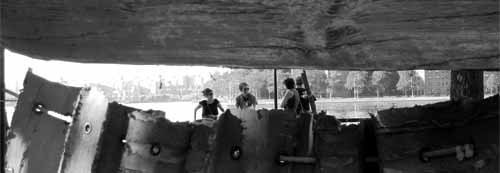These mask-like forms take on the contours of the structure, as well as the surface of the house's actual skin, in great detail. The panels preserve splinters of weathered and warped wood, flakes of peeling paint, the outlines of nails, and the accordion folds of shutters.
photos by Rosa Phoenix
Walking through the little house, touching the quivering, rubbery walls, is a strange experience. Held up by steel cables, the panels sag weightily, much as the actual house probably sagged after enduring 100 years of wood-warping, paint-peeling tropical heat and humidity.
We wander through the empty rooms of this tiny floorless, roofless space wondering what secrets this house held while it still lived—while it was still a container of human life and activity.
New Orleans was always known for its ghosts, its glorious and cursed history, its mystery and morbidity, its inequity and stark surreal contrasts of society.
"Social Dress," the other part of the sculpture's title, could refer to the empty shell of this house, and to the character of the city itself, a city known for its carnival masks, costumes, and obsession with fantasy, beauty and spectacle amid the poverty of harsh reality.
Part of the bizarre feeling of the installation is the fact that this is not the actual house, but the man-made mask of the house, molded from the original building, uprooted and shipped to New York City, to a grassy bit of land overlooking the East River and the towering skyscrapers of Manhattan across the water.
From inside the house looking out through the windows and through the seams where the panels of wall don't quite meet, the view seems exotic and out of place.
photos by Rosa Phoenix
Within this house, we may touch its ancient surfaces and imagine the lives lived before, and mourn them. But we can never hope to intimately know the secrets of the dead and gone contained within its walls.
LINKS
Socrates Sculpture Park
Takashi Horisaki












